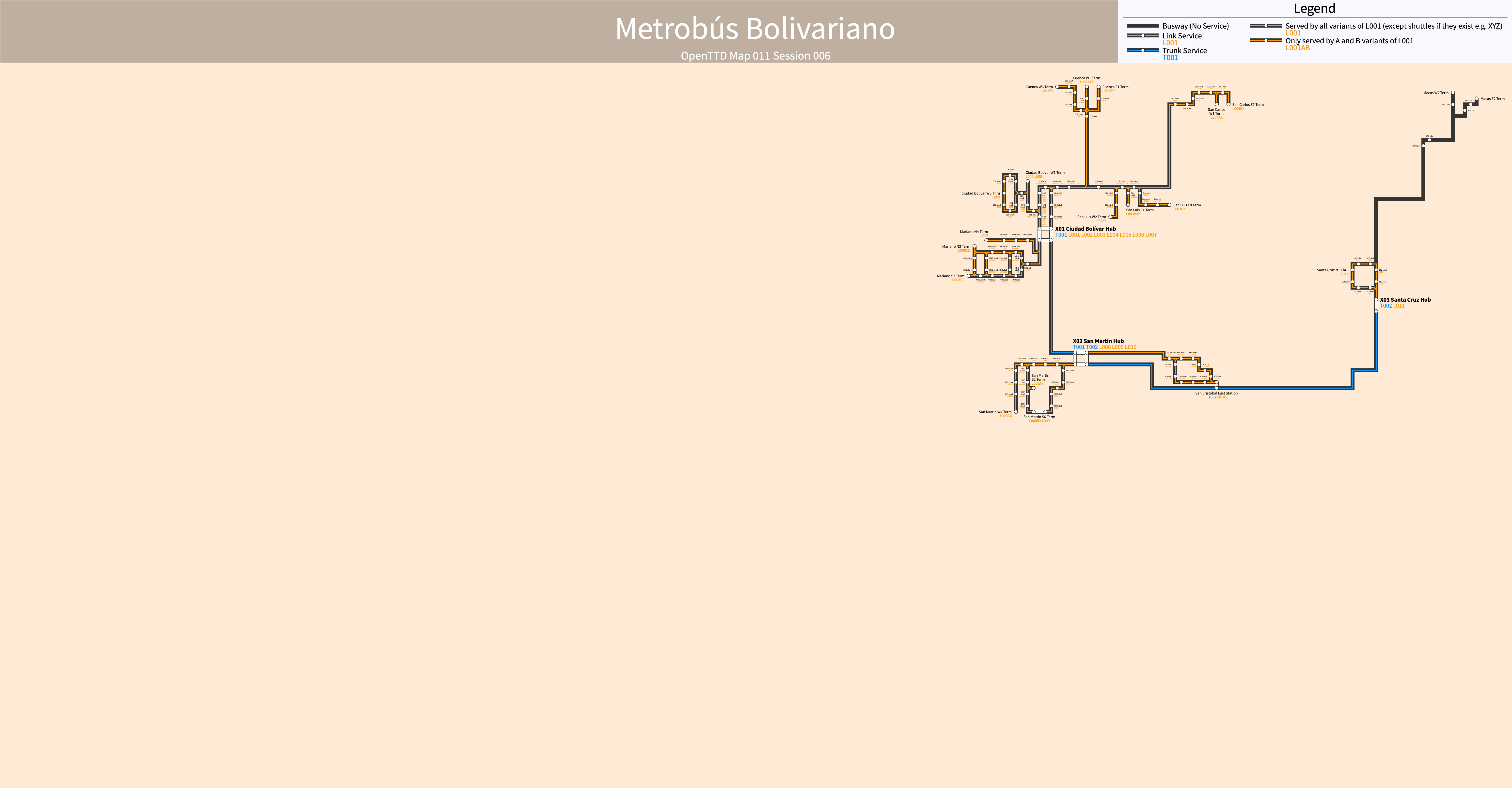011 Metrobús Bolivariano, OpenTTD
Table of Contents
Overview - 011 Metrobús Bolivariano
The Metrobús Bolivariano Sistema Integrado de Transporte aims to provide all citizens with high quality bus rapid transit no matter where you live. Whether you are taking a local Link/Alimentador service or an intercity or interregional Trunk/Troncal service, we aim to deliver you to your destination in a safe and efficient manner.
With city expansion built around our Metrobús service and service across the northeast, we are pleased to serve customers in Cuenca, Ciudad Bolívar, San Luís, Mariano, San Carlos, San Martín, San Cristóbal, Santa Cruz, Macas and Oruro, and Neiva. We would also like to apologize to citizens of Mariano for designing infrastructure that results in incomprehensible service patterns.
Design Methodology
In Multi-009 Hellerhuizen, the first version of my Trunk Routes Standards was developed, but I grew dissatisfied with it nearly immediately due to some fundamental design flaws. Infrastructure in Link and Trunk systems was physically built to different standards, one directional roadways were used inefficiently, and terminal stations were massively overbuilt. There was a whole selection of different types of stations in play, and it was simply EXHAUSTING.
That isn't to say that the Metrobús Bolivariano was perfect - if anything, it was not. Two fundamental changes were made midway through the map. First, the way I initially built things out was aligned against the 3x3 grid in play (which I also used to have a game map scale map). At the start I didn't have any real concrete plans for dedicated trunk/local services, partially due to operations and partially due to a belief that the initial system of running a dozen feeder routes down a trunk would solve things. It did not - I got horrible bunching which caused station ratings to tank on the outer parts of the network. I introduced services for the sole purpose of keeping station ratings up but these were obviously a waste. A side effect of this was that I ended up implementing a messy reverse branch for capacity reasons in addition to a network mostly comprised of three width roadways that were never used optimally due to pathfinding.

Ciudad Bolívar at the end of Session 002. Shown: Original ROW style (dedicated one way outer and two way middle with full 5x3 stations), including reverse branch setup. Trunk T001 was not yet in service at this time but the terminal is present.
And so this brings us to the Cutover, whereby I built new ROW for a trunk route, redid all terminals to make them more efficient, converted large chunks of existing roadway to trunk route only, and segmented/split plenty of services in the original area. I also adjusted Link ROW standards to make them one tile thick for the most part because most services would never need the capacity afforded by the wider overbuilt ROWs and the stations themselves were eating into the available catchment area of the stations. Some areas were exempt due to high loads but not all.

Cuenca before the cutover. Note how three services merge before engaging on a long journey through nothing.

Cuenca after the cutover. Cuenca is now a stop on a dedicated intercity service that also connects to San Carlos directly. Conversion of this area to proper trunk-feeder has concluded.

System map (top half) right before the cutover. Note how I was planning on repeating the long distance feeder mistakes of the past in the new ROW in the east. However, a plan to build a trunk line from Cuenca/San Carlos got me to do it properly on the east side.
Overall this was an interesting experience, though by the end the knowledge that the ROW style just wasn't working was firmly set. Unfortunately, the 3x3 setup with dedicated ROW aligned to the roadway grid effectively makes the middle lane a waste of space, and pathfinding needs to be a proper consideration.
